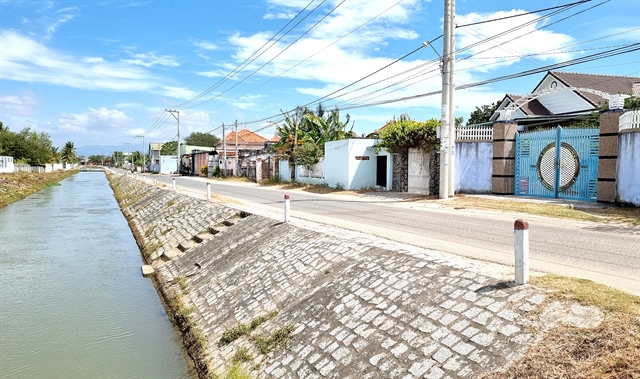 Society
Society

 |
| Moving up: The higher living standards of the Chăm people are evident in Ninh Phước District’s Phước Hữu Commune, Ninh Thuận Province. — VNA/VNS Photo Nguyễn Thành |
NINH THUẬN — Life has improved significantly for many Chăm households in Ninh Thuận as a result of value adding agricultural interventions by provincial authorities.
The south-central province, about 350km from HCM City, has 19,239 Chăm households with 85,343 members, accounting for 11 per cent of its population, according to official records.
The Chăm, who form the largest ethnic minority community in the province, live mostly in the districts of Ninh Phước, Thuận Nam, Ninh Hải, Ninh Sơn and Thuận Bắc.
In Ninh Phước’s Phước Hải Commune, local authorities have guided the Chăm residents in cultivating asparagus, tomato, papaya, peanuts and other crops in hitherto unfertile and semi-desert areas.
Châu Thị Xéo, director of the Châu Rế General Agriculture Service Co-operative in Phước Hải, said authorities and the co-operative had encouraged local households to switch to growing high-value asparagus and invested funds in drilling bore wells and installing automatic irrigation systems.
The co-operative had linked up with more than 80 households to grow asparagus on a 20ha field and bought about 300 kilogrammes of asparagus every day at VNĐ45,000 (US$1.9) a kilogramme.
This had helped households earn an average profit of VNĐ500,000 ($21) a day per 1,000 sq.m of asparagus, Xéo said.
When the co-operative was established, it had seven poor households as its members. The switch to asparagus cultivation resulted in the households escaping poverty and earning high incomes, she added.
Ninh Phước has the largest number of Chăm people in the province at 11,157 households with 51,000 people.
Bạch Văn Nguyên, chairman of the Ninh Phước People’s Committee, said the district had assisted farmers in developing effective production models embedded in value chains so as to increase economic efficiency.
He said these included: the cultivation of asparagus, grape, jujube, rice, corn and vegetables; the rearing of cows, sheep and goats; and the making of brocade and pottery products.
The district’s per capita income reached VNĐ64.4 million ($2,700) last year, up VNĐ320,000 against the annual target.
The district aimed to increase its per capita income to VNĐ71.4 million ($3,000) and reduce the poverty rate to 2.48 per cent this year, compared to 3.48 per cent last year.
Driest province
Ninh Thuận, the country’s driest province, is also its main producer of grapes, sheep and goat.
The provincial administration has consistently implemented both central and local policies and programmes to improve the lives of its residents, particularly in ethnic minority areas.
These policies, including building new-style rural areas, have revolved around poverty reduction, according to the province’s Ethnic Minority Affairs Committee.
Today, all Chăm residential areas have power, health clinics, commune-cultural houses and primary schools.
Eleven of 13 communes populated by the Chăm people have been recognised as new-style communes.
Community-based management models have engendered several positive, life improving changes including clans having no members violating laws, peaceful villages and the establishment of crime prevention clubs.
Tasks ahead
Despite the progress made, many Chăm areas are facing a host of problems including harsh natural conditions exacerbated by climate change impacts and limited investments.
At the end of last year, there were 829 poor Chăm households and 1,447 near-poor ones, accounting respectively for 7.5 per cent and 14.3 per cent of the province’s total in the two classifications.
Nguyễn Long Biên, deputy chairman of the Ninh Thuận People’s Committee, said the province would mobilise funds from various sources to effectively implement ethnic minority support policies this year.
It would continue to focus on poverty-reduction programmes, building new-style rural areas and promoting socio-economic growth in ethnic minority areas per its 2021-25 development plan, he said.
Biên further specified that the province planned to mobilise more than VNĐ2.78 trillion ($120 million) from central and local budgets, loans and private investors by 2025 to invest in infrastructure to serve production activities and improve the lives of ethnic minority residents.
It wpuld give farmland and housing land for the needy to develop agricultural production with an aim to attract investment for developing large-scale farming areas in areas where the Chăm live.
Agriculture extension officials would impart knowledge of advanced farming techniques to help households cultivate high value crops and livestock.
The province would also increase the number of Chăm government officials while teaching the Chăm language to State officials and staff working in areas inhabited by the ethnic minority community to improve the quality and efficiency of services rendered. — VNS




